- News
- Reviews
- Bikes
- Accessories
- Accessories - misc
- Computer mounts
- Bags
- Bar ends
- Bike bags & cases
- Bottle cages
- Bottles
- Cameras
- Car racks
- Child seats
- Computers
- Glasses
- GPS units
- Helmets
- Lights - front
- Lights - rear
- Lights - sets
- Locks
- Mirrors
- Mudguards
- Racks
- Pumps & CO2 inflators
- Puncture kits
- Reflectives
- Smart watches
- Stands and racks
- Trailers
- Clothing
- Components
- Bar tape & grips
- Bottom brackets
- Brake & gear cables
- Brake & STI levers
- Brake pads & spares
- Brakes
- Cassettes & freewheels
- Chains
- Chainsets & chainrings
- Derailleurs - front
- Derailleurs - rear
- Forks
- Gear levers & shifters
- Groupsets
- Handlebars & extensions
- Headsets
- Hubs
- Inner tubes
- Pedals
- Quick releases & skewers
- Saddles
- Seatposts
- Stems
- Wheels
- Tyres
- Health, fitness and nutrition
- Tools and workshop
- Miscellaneous
- Cross country mountain bikes
- Tubeless valves
- Buyers Guides
- Features
- Forum
- Recommends
- Podcast
review
£1,600.00
VERDICT:
Performance orientated folding bike, with good spec and impressive ride - but we had some folding niggles
Weight:
10,650g
Contact:
www.evanscycles.com
At road.cc every product is thoroughly tested for as long as it takes to get a proper insight into how well it works. Our reviewers are experienced cyclists that we trust to be objective. While we strive to ensure that opinions expressed are backed up by facts, reviews are by their nature an informed opinion, not a definitive verdict. We don't intentionally try to break anything (except locks) but we do try to look for weak points in any design. The overall score is not just an average of the other scores: it reflects both a product's function and value – with value determined by how a product compares with items of similar spec, quality, and price.
What the road.cc scores meanGood scores are more common than bad, because fortunately good products are more common than bad.
- Exceptional
- Excellent
- Very Good
- Good
- Quite good
- Average
- Not so good
- Poor
- Bad
- Appalling
The Tern Verge X30h is a small-wheeled folding bike, but it displays none of the utilitarian features usually associated with this genre. Instead, it's a sporty little number, with slick tyres, aero-wheels, some nice kit and a fancy paint job. Without doubt, it looks fast. And, as folding bikes go, it rides pretty fast as well. But when it comes to the actual folding, some features leave a lot to be desired.
Tern may be a relatively new brand, but it has an impressively large range of bikes, ranging from a chunky urban workhorse called Castro to the svelte and slinky Verge series, which has six varieties, including this X30h that I've been testing for the last month or so.
With any small-wheeled folder, comparisons with bikes such as Brompton and Dahon are inevitable - the latter especially so as the Tern company was founded by Joshua Hon, the son of David Hon, the founder of Dahon.
But we're not here to talk about family intrigue. Let's talk about the bike, and see what the Verge x30h is made of.
Frame & fork

The frame is made from welded 7005 aluminium. There's a short head tube, a long single tube joining the front and back of the bike (with the main vertical hinge halfway along), and a small rear triangle with the seat stays divided in front of the seat tube to provide extra stiffness in what's called 'Double Truss technology'.
The seat tube (and contiguous seatpost) is very upright - measuring 80 degrees on the road.cc protractor. In reality, it's a slightly less severe angle (around 77 degrees) because the seat tube comes down behind the bottom bracket shell, rather than bang on top of it, as on most conventional bikes.

That's still pretty steep though. With the saddle central in the seatpost clamp, the tip of the saddle is about 30mm behind a vertical line drawn through the centre of the bottom bracket. With the saddle pushed back as far as it would go, I managed to get this distance to about 40mm. This compares with 65mm on the bikes I usually ride. Unsurprisingly, I felt I was sitting directly above the bottom bracket rather than a tad behind it.

The headtube is short and stubby, with an angle of about 75 degrees. The 'handlepost' (effectively an extension the head tube, with a hinge at the base - part of the folding mechanism) is bolted on top of the forktube/steerer and is at an even steeper angle of 85 degrees, mirrowing the upright position experienced with the seatpots.
Bullhorn style handlebars give you two main riding positions that mirror the tops and hoods of conventional drop bars. The brake levers are connected to the ends of the bars, but it's not possible to ride on the real hoods.

The handlebars are connected to the handlepost by what Tern call a 'stem' manufactured by Syntace. In reality, this stem is a pair of clamps. It's not the sweetest thing to look at, but via a pair of bolts it can be swivelled which allows the reach and height of the bars to be adjusted about 25mm forward/back and up/down. The angle of the bars can also be adjusted this way.
Equipment

The transmission and gearing consist of FSA cranks and single front chainwheel, combined with an Ultegra rear mech on a SRAM 10-speed 11-26 cassette, plus a SRAM dual drive 3-speed hub gear. This gives a total of 30 gears with a massive range from 28 to 121 inches. That's roughly equivalent to a lowest gear of 34x32 on a bike with 700c wheels, and a highest gear of 50x11. All of these gears are usable (unlike a 10-speed cassette with triple chainrings) with no uncomfortably big jumps between the ratios.
The combined brake levers and gear shifters are Tiagra STI. Using the mech or the hub gear, I found the gear changing slick and precise - in fact it was smoother than using triple rings or a compact.

An oddity on this bike is the 'window' on the top of the levers with a needle that indicates which gear you're in. Handy on a conventional bike, but the angle of the levers on this Verge means there's no chance of seeing the needle unless you lean so far forward you're in danger of tumbling over the front wheel.
The 20-inch wheels are a mix of American Classic alloy rims and front hub, with Sapim spokes (just 14 spokes in a radial pattern in the front) and a SRAM rear hub (more on that later). The wheels have medium-depth aero rims, which look cool, although whether they actually offer any real aerodynamic advantage might be open to dispute.
The wheelbase is 1020mm - about the same as my touring bike.

The tyres are 28mm Schwalbe Duranos - the Kevlar-beaded puncture-protected version with a recommended psi of 100 to 120. Throughout this test I ran both tyres at 120psi.
Other bits of kit include a Kore saddle, Kinetix brake callipers, Live Wire cables and Flux Pro headset. All in all, a nice package, giving the bike a total weight of 10.65kg.
Ride

Nice kit means nothing if a bike doesn't ride well. However, as small-wheeled folders go, the Verge rides well. The hinges on the handlepost and main tube are very firmly locked together and show no sign of movement. And despite having only one main tube between the front and back ends of the bike, the ride is positive with only a bit of perceptible flex.
It might be conscious design decision to allow some flex (and call it 'compliance') to counteract what might be a harsh ride from the small wheels and high-pressure tyres. Or it might be luck. Either way, the ride was comfortable without being sloppy, and I found the bike cruised along very happily during some 20-mile test-rides on the flatter country lanes around road.cc Towers.
Hills, however, were a different story. Standing up with hands on the 'hoods' bit of the bars was a precarious operation. The frame flexed considerably, and combined with the upright position, high handlepost and small wheels, the whole bike felt unstable. Sitting down with hands on the tops (and using that 28-inch bottom gear) provided a much more successful ascent.
Going downhill also took some care. Leaning into a corner on a fast descent, the bike became unstable again and I nearly ended up in the ditch. Keeping to a steady speed, everything was fine.
So overall, the ride on the Verge is great as long as you remember it's a small-wheeled folder, and don't try to climb or descend energetically as if it was a conventional bike.
On hills or on the flat, the riding position of the bike took a lot of getting used to, but with some tweaking (moving the saddle back as far as it would go, and dropping the bars as far as they would go) I managed to get it close to the position on my touring bike - although the bars were still much higher and the reach shorter than on my racing bike.
But just because it works for me, it doesn't mean it'll work for everyone of course. I'm 5ft 10 - wonderfully average - and that seems to be the size this bike is designed for, give or take a couple of inches. Tern claim anyone between 4ft 8 and 6ft 3 can ride the bike, but I'm not so sure. For anybody shorter than 5ft 6, the reach would be OK but the bars might be too high - even at their lowest setting. For anybody 6ft or more, the bars might be at the right height, but the reach would be too short.
I can't help wondering why the bike doesn't have a conventional flat handlebars with a conventional A-head stem attached to the top of the handlepost. This would allow riders to fit a long or short stem (with a steep or shallow angle) to suit their height and riding preference. The hoods position could still be achieved with a set of bar-ends, and the 30 gears still controlled with hybrid-style thumb-push levers. This option is indeed available on some other Verge models, so maybe the drop-style bars and shifters are deliberate to give this X30h its more sporty looks.
Talking of looks, there's no denying this bike is a stunner, with sexy swooping lines and a beautiful yellow and grey paint job. The aero-style rims may be just for looks, but in matching yellow they just add to the glamour, as do the yellow bits on the saddle.
Back to reality, other features include an optional front luggage rack - which fits onto a neat little boss ingeniously disguised as the head-tube badge.
Folding
Last but very definitely not least let's talk about the fold. The Verge is one of the best small-wheeled folding bikes I've ever ridden - but it's still undeniably a folding bike. So let's look at the way it folds in more detail.

There are two main options: the first is what might be called the 'half-fold'. You flip a handle on the side of the vertical hinge on the main frame-tube, and fold the bike in half, at the same time turning round the front fork, so the bike concertinas, and the front and back wheels are side by side. It's exceptionally neat and quick. It might be all you need to do to get the bike in the boot of your car or the cupboard under the stairs - without needing to fold the seatpost or handlepost.
The way the handle covers the inside of the hinge when the bike is folded is a simply beautiful design feature. As is the pair of little magnets near the front and rear dropouts, to hold the two halves of the bike together and stop them swinging on the hinge.
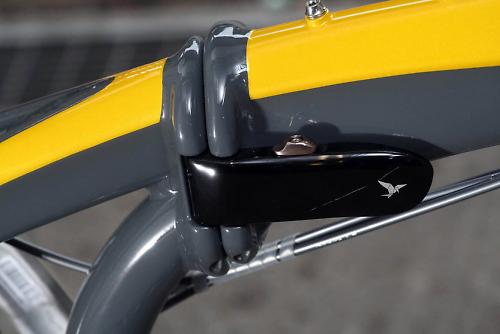
Or it would be if the magnets touched each other properly. The one on the front is adjustable, but on our test bike no amount of tinkering could change the position so it fully engaged with its partner on the rear. So the bike swung around on its hinge as I lifted it into the car - exactly what it's not supposed to do. We've subsequently been told that our test bike was a production prototype which may account for the problem of alignment and which we've been assured was also the cause of our other big niggle with the Tern when folded - it kept falling over when folded. As I say Tern assure us that this was a problem confined to our test bikes and that production versions do stand up when folded - assurances we're happy to accept. You however, might still want to try folding it and then seeing if it will stay upright when your're in the shop.
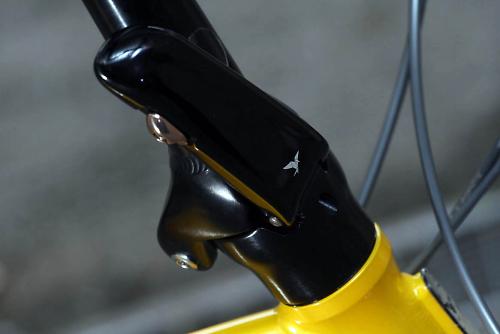
All of which means I've rather jumped ahead of the second folding option which is what might be called the 'full-fold'. First you open the quick release lever on the seatpost clamp and drop the seatpost down as far as it will go. (The base of the seat post with the two wheels in the folded position together form a tripod so the folded bike can stand up on its own.) Then you fold the bike on the main hinge and reverse the forks, as described above. Then you open another handle on the handlepost hinge, and swing the bars down so they're level with the front wheel.
It sounds neat, but even when folded, the bars and shifters still stick out perpendicular to the rest of the folded bike. To get them closer to the frame and front wheel in the folded position requires loosening the clamp that holds the bars to the handlepost. This needs an allen key - there's no quick release lever. So it's not the work of a moment. That of course brings us back to the eternal compromise inherent in any folding bike and the question it poses anyone buying one - which side of the equation is more important, the folding bit or the bicycle bit? If you want ride performance in our experience you are going to have to give a little on the size and neatness of the folded package, as the Tern proves yet again.
Apart from that apparent design oversight in the folding system on our test model, the Verge is a lovely bike. The ride-quality is great for a small-wheeled folder, as long as you don't throw it around on the hills. It might be the perfect mount for the commuter who likes to ride fast but still needs to keep the bike under their desk at work. In the same way, it might be ideal for those with limited storage space at home but still wanting a performance-orientated bike to do some fast miles at the weekend.
Verdict
Performance orientated folding bike, with good spec and impressive ride - and some limitations. The folding itself is let down by a few peculiar design features.
road.cc test report
Make and model: Tern Verge X30h
Size tested: Orange
About the bike
Frame and fork
Overall rating for frame and fork
8/10
Tell us about the build quality and finish of the frame and fork?
For a bike of this sort, the build quality is very good, with very neat welding. The finish is also very good, with a nice paint job.
Tell us about the materials used in the frame and fork?
The frame is made from welded 7005 aluminium.
Tell us about the geometry of the frame and fork?
The seat tube (and contiguous seatpost) is very upright - measuring 80 degrees. In reality, it's a slightly less severe angle (around 77 degrees) because the seat tube comes down behind the bottom bracket shell, rather than bang on top of it, as on most conventional bikes. That's still pretty steep though.
The headtube is short and stubby, with an angle of about 75 degrees. The 'handlepost' (effectively an extension the head tube, bolted on top of the forktube/steerer) and is at an even steeper angle of 85 degrees.
The end result is an undeniably upright riding position.
How was the bike in terms of height and reach? How did it compare to other bikes of the same stated size?
The upright riding position took a lot of getting used to, but moving the saddle back as far as it would go, and dropping the bars as far as they would go, I managed to get it fairly close to the position on my touring bike - although the bars were still higher and the reach shorter than on my racing bike.
Tern claims that anyone between 4ft 8 and 6ft 3, but I'm not so sure. For anybody shorter than say 5ft 6, the reach would be OK, but the bars might be too high - even at their lowest setting. For anybody 6ft or more, the bars might be at the right height, but the reach would be too short.
Riding the bike
Was the bike comfortable to ride? Tell us how you felt about the ride quality.
For a small-wheeled folder the bike was remarkably comfortable, and the ride quality was
Did the bike feel stiff in the right places? Did any part of the bike feel too stiff or too flexible?
When seated, the bike felt reasonably stiff. There was some very mild flex, but it seemed to make the bike more comfortable.
How did the bike transfer power? Did it feel efficient?
When seated, yes.
Tell us some more about the handling. How did the bike feel overall? Did it do particular things well or badly?
When standing up, with hands on the 'hoods', the frame flexed considerably, and combined with the upright position, high handlepost and small wheels, the whole bike felt unstable. Sitting down with hands on the tops provided a much more successful ascent.
Going downhill also took some care. Leaning into corners at speed, the bike became unstable. Keeping to a steady speed, everything was fine.
Overall, the ride on the Verge is great as long as you remember it's a folder, and don't try to climb or descend energetically as if it was a conventional bike.
Which components had the most effect (good or bad) on the bike's comfort? would you recommend any changes?
The only change I'd recommend would be swapping out the current 'stem' for a real stem - either combining that with the current bars, or conventional drop bars, or even straight bars.
Which components had the most effect (good or bad) on the bike's efficiency? would you recommend any changes?
Most of the components were ideal for this bike - I was most impressed by the SRAM hub gear standing in for a triple chainset.
Rate the bike for efficiency of power transfer:
8/10
For a small-wheeled folder, power transfer was very good.
Rate the bike for high speed stability:
8/10
For a small-wheeled folder, the bike was stable on the flat at high speed
Rate the bike for low speed stability:
9/10
Weaving in and out of traffic, the bike felt very stable at low speed
Rate the bike for flat cornering:
7/10
For a small-wheeled folder, cornering on the flat was good
Rate the bike for cornering on descents:
3/10
The bike was unstable and unpredictable cornering on descents
Rate the bike for climbing:
3/10
Climbing out of the saddle was unstable and uncomfortable
The drivetrain
Rate the drivetrain for performance:
9/10
The Ultegra rear mech on a SRAM 10-speed 11-26 cassette, combined with the SRAM dual drive 3-speed hub gear, was a sweet as a nut.
Wheels and tyres
Rate the wheels and tyres for performance:
10/10
For a small-wheeled folding bike, the wheels and tyres were excellent. The wheels were taught, and with the tyres pumped up to 120psi, the bike could spin along at speed very nicely.
Controls
Rate the controls for performance:
9/10
The combined brake levers and gear shifters are Tiagra STI. Using the mech or the hub gear, I found the gear changing slick and precise - in fact it was smoother than using triple rings or a compact.
Your summary
Did you enjoy riding the bike? Yes
Would you consider buying the bike? Yes, if I wanted a sporty-looking performance-orientated small-wheeled folder
Would you recommend the bike to a friend? Yes, if they wanted a sporty-looking performance-orientated small-wheeled folder
Rate the bike overall for performance:
8/10
Rate the bike overall for value:
7/10
Anything further to say about the bike in conclusion?
Many of the comments above are preceeded by the phrase "For a small-wheeled folder...", but that's because it's not fair to compare aspects of this bike, such as handling or performance, with a standard size bike.
So, for one last time, as a small-wheeled folder, the Tern is good bike, and thoroughly deserves its overall score of 7. The componentry, build-quality and ride-quality (when seated) might have sent the overall score up towards 8, but it's brought down again by the upright position, the handing on hills, and the lack of quick-folding handlebars.
As with any bike, the Verge has some limitations. If you want a bike that folds down smaller and more quickly, then consider something like a Brompton. If you want a folding bike with bigger wheels that's more like a conventional bike, then consider something like an Airnimal (or move away from folders alltogether and look at full-sized de-coupled machines such as the Qoroz Travel Bike). The Verge X30h is not perfect, but for a folding bike it's a good compromise between performance and practicality.
And, yes, we know what 'verge' means in French.
About the tester
Age: 50 Height: 5ft 10 / 178cm Weight: 11 stone / 70kg
I usually ride: an old Marin Alp My best bike is: an old Giant Cadex
I've been riding for: Over 20 years I ride: A few times a week I would class myself as: Experienced
I regularly do the following types of riding: touring, club rides, sportives, general fitness riding,
Latest Comments
- Rendel Harris 2 min 54 sec ago
I expect if we frequented truckdriver websites that featured articles on the truck drivers being unfairly treated (which I agree they are) in this...
- RobD 6 min 31 sec ago
Well they're definitely not cheap
- Rendel Harris 6 min 32 sec ago
That's a heck of a low weight limit isn't it? As the weight limits generally mean everything that you carry on a bike, including clothes, helmet,...
- Secret_squirrel 12 min 13 sec ago
Um.... quite easily because there is much much more to being inspired than watching a load of highly paid professionals on telly in the TdF....
- SaveTheWail 43 min 30 sec ago
'A group of parents have said their children's school run is becoming increasingly dangerous because of a "nightmare" zebra crossing.' It's the...
- chrisonabike 1 hour 6 min ago
And other counties also have done this IIRC with total cost/ benefit - including contribution to businesses and shopping - with similar results. (I...
- DrG82 1 hour 29 min ago
In what way? Suspension on this type of bike or one a single leg?
- chrisonabike 1 hour 31 min ago
You can have a portable mini-carillon for not too much effort.
- froze 4 hours 46 min ago
I pray Wiggins has found peace and happiness; he was a great cyclist, no one can take that away from him. And a huge thanks to Lance Armstrong for...
- lonpfrb 10 hours 33 min ago
It's easy to remove the pipe from the fasteners which are C shaped so able to hold but not trap the pipe. Filtering through traffic is then...

























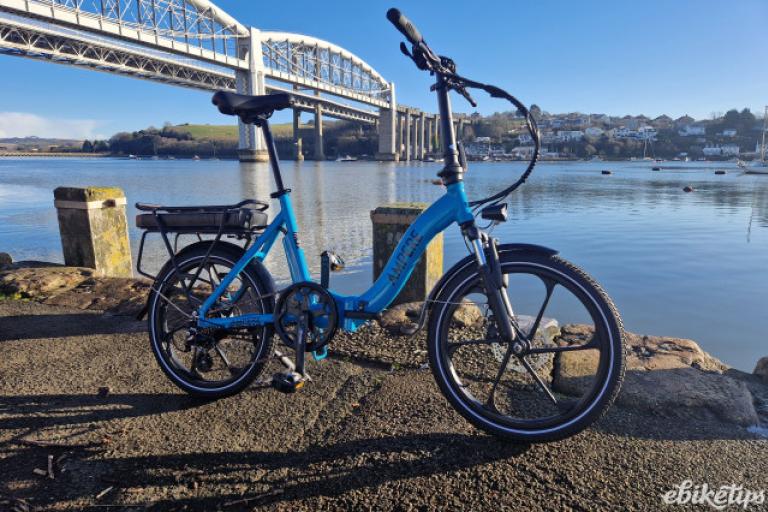
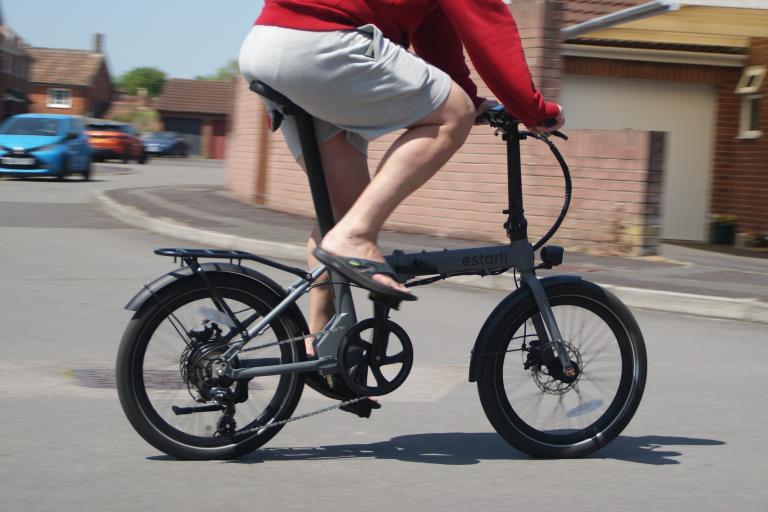
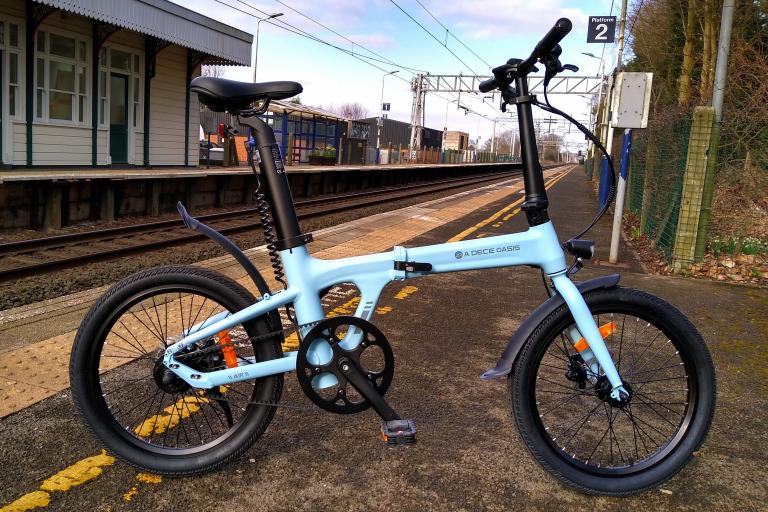
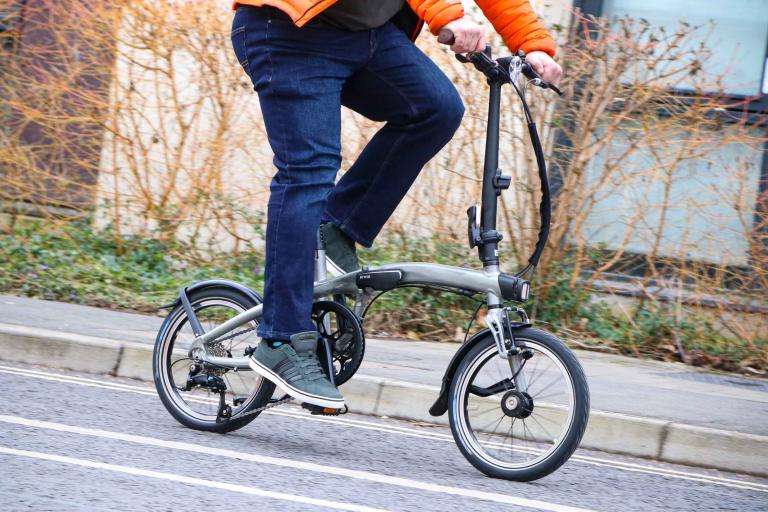
Add new comment
6 comments
Thank you for the very detailed review.
I have one question though, I broke the threaded tube on the front brake (see attached picture) any idea what model is that so I can buy some spares?
Thank you
tube_1.jpg
I've got a Dahon Speed Pro TT (predecessor to this bike), and it's great, so I'm sure the Verge X30h is even better. Shame that, as with the recent BikeRadar test of the equivalent Dahon Vector X27h, David insisted on trying to climb out of the saddle. Apart from putting a higher level of stress on the handlepost (the Tern one is stronger, but...), all it does is make the bike's frisky handling positively unstable. The frame won't help that, but it's more down to the small wheels (which react more quickly to all steering inputs, including inadvertent ones!). As David seems to have realised, the way to ride this kind of bike is to sit and spin, and to work with its quirks. I find the Speed Pro TT barely slower than my road bikes. It would be more than up the job of a long ride- I'm planning to do at least one century on it!
Thanks for these comments, chaps.
@Raleigh - I do cover this point in the review. As Mark, the man from Tern UK, has noted above, flat bars are available on other Verge models.
@Bosh - Yes, 'verge' is a French word, and we know what it means, as mentioned at the end of the review. But road.cc is no place for schoolboy sniggering.
Do you think that this bike would be better with flat bars or even drops?
What does having the bullhorns add aside from making it flatter when folded?
The shifters could be replaced with some rapid fire shifters perhaps?
I'm sure verge is French for something... Anyone got any ideas
Thanks for a very fair review which clearly identifies the amazing performance that has been incorporated into this folding bike. You have pinpointed the highs and lows of a bike that is designed specifically for the customer whose priority is the ride rather than the fold.
All said and done, making a bicycle that folds and unfolds comes with a series of compromises which change depending on the goal of the model. How you adjust the individual compromises is a bit like mixing a music track with lots of sliders, except you just can’t have maximum on all sliders. E.g. improve gear range = increase weight etc
What Tern does well with the Verge X30h is to:
• make full use of our new and extremely stiff frame,
• combine it with an outstanding component package
• match it to the size and shape of a wide range riders.
As to the folding function which seems to be the main criticism, all I would say is that for customers looking for a PORTABLE solution with fast and compact fold, the mix needs to be changed, and we have a whole range of other “bikes that fold” which are much more portable but perhaps less like a fast road bike!
If the X30h @ £1600 requires too much effort to fold, we do of course have the Tern Verge X20 (with flat bars and Sram red etc.) but with those weight savings come a higher price tag (£2200).
For the guy who needs their folding bike to be a performance bike, we think sacrificing a little folding convenience for some serious performance was a price worth paying at cost that is pretty reasonable.